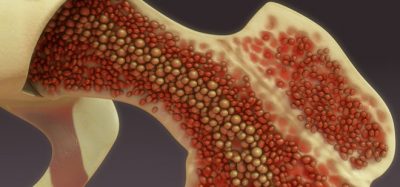Self-delivering RNAi: paving the way for a new class of cancer immunotherapies
Posted: 4 December 2018 | Geert Cauwenbergh | No comments yet
Earlier this year, the National Cancer Institute published its annual report to the nation on the status of cancer stating that there will be nearly 1.8 million new cases of cancer in 2018.1 New therapies have developed over time to improve cancer patient outcomes, including antibody immunotherapies targeting immune checkpoints, such as PD-1. An example is KEYTRUDA® (pembrolizumab), which came to the market in 2014 to treat solid tumours.2 Immunotherapy is rapidly becoming a powerful tool available to physicians and patients to attack cancer with fewer side effects than traditional standard treatments such as surgery, radiotherapy and chemotherapy.3
In the same way that cancer treatments have evolved, new treatment modalities have been developed based on RNA interference (RNAi), offering a highly specific pathway to treat a number of diseases. RNAi was co-discovered in 1998 by Andrew Fire and Craig Mello, who later received a Nobel Prize for their discovery.4 This year, the first RNAi-based drug was approved by the US Food and Drug Administration (FDA) and the European Medicines Agency (EMA), paving the way for a new and improved treatment approach.5 Unique in the RNAi space is a therapeutic platform technology called “self-delivering” RNAi, or sd-rxRNA®. The sd-rxRNA platform is poised to meet the unmet need of other cancer therapeutic approaches, such as antibodies, small molecules and gene editing.
Leveraging RNAi in the development of sd-rxRNA
RNAi is a naturally occurring process by which short double-stranded RNAs interfere with the expression of targeted genes. The development of therapeutics based on RNAi technology utilises this phenomenon enabling the reduction of the expression of particular genes within living cells. RNAi offers a novel approach to the drug development process because RNAi compounds can be designed to target any one of the thousands of human genes, many of which are undruggable by other modalities.
A successful RNAi therapeutic platform requires stable, specific and potent RNAi compounds and the ability to deliver these compounds to the tissue(s) of choice. One conventional solution involves encapsulation into a lipid-based particle, such as a liposome, to improve circulation time and cellular uptake. Scientists at RXi have used an alternative approach to delivery in which drug-like properties are built directly into the RNAi compound itself. These novel compounds are termed sd-rxRNA.
The proprietary combination of chemical modifications that results in spontaneous cellular uptake of sd-rxRNA without the need for a delivery vehicle was discovered through systematic medicinal chemistry screening. sd-rxRNAs are hybrid oligonucleotide compounds that combine the optimal properties of both conventional RNAi and antisense technologies.3
Advantages of sd-rxRNA in immuno-oncology over other modalities
Immunotherapies provide a powerful means of destroying tumour cells by harnessing the immune system to restore surveillance of evaded tumours. Cancer immunotherapy targets the defective process that enables cancer to develop in the first place, by restoring or improving immune surveillance processes that normally prevent abnormal cells surviving and expanding.
The therapeutic and built-in delivery properties of sd-rxRNA compounds provide a powerful means of harnessing the immune system to attack cancer by improving immune effector cell function, boosting immune effector cell fitness and persistence, and increasing tumour cell recognition and immunotherapy susceptibility.
Several key attributes of sd-rxRNA compounds fulfill the unmet needs of other treatment approaches. For example, today antibodies have the largest market share in the immuno-oncology space; however, they can only target extracellular proteins one or two at a time. In contrast, sd-rxRNA has been proven to address both intra- and extra-cellular targets, alone or in combination, simultaneously silencing multiple genes in a single therapeutic entity.6 Moreover, the lower cost of goods and faster lead generation time of approximately four months, in comparison to years for an antibody or small molecule, is a key differentiator of the sd-rxRNA platform. In addition, small molecules are far less specific than RNAi-based therapeutics, meaning that there is a higher risk of side effects, and chance of developing resistance to that treatment.
Cell-based approaches using genetic modifications are currently also being used in immuno-oncology. Gene editing is a complicated process with much less predictability of which genes are impacted, yielding unknown long-term effects. Gene editing may face regulatory scrutiny due to the very nature of altering a patient’s genetic code. sd-rxRNA compounds do not modify the genetic code and, importantly, the compounds demonstrate high transfection and efficiency into targeted cells and tissues with no impact on cell viability.7 The safety and versatility of the platform lends itself well to both cell-based immuno-oncology as well as direct therapy with intra-tumoural injections.
Tackling different immune escape mechanisms to treat cancer
Improving immune effector cell function
Central to the immune system’s activity against cancer are the immune-effector cells, such as tumour infiltrating lymphocytes (TILs). Emerging therapies are therefore being developed to boost these cells through the use of the adoptive cell therapy (ACT) method. This is a process by which immune cells are obtained from a patient or cell bank, expanded and treated ex vivo, then reinfused into a patient. Given that sd-rxRNA compounds are highly amenable to local delivery applications, the addition of a pre-treatment of immune cells with sd-rxRNA compounds can be used to silence one or more immuno-suppressive genes (such as PD-1 and other checkpoints), thereby weaponising the immune cells, boosting their ability to detect and destroy tumour cells.
Studies have been conducted evaluating the potential of improving TIL therapy by applying sd-rxRNA compounds specific to PD-1. The results show that targeting the PD-1/PD-L1 axis can enhance the ex vivo expansion rate and in vivo longevity of patient-derived TILs used for ACT in malignant melanoma patients. Transfection of these T-cells with the PD-1 targeting self-delivering sd-rxRNA compounds was easy to incorporate in an established, clinically-relevant rapid expansion protocol and resulted in increased functionality of the transfected TILs against autologous tumours as compared to control TIL. This presents a potential opportunity to improve ACT outcomes in cancer patients.8
Boosting immune effector cell activity, fitness and persistence
Apart from a role in ACT with autologous T-cells (TILs), sd-rxRNA can also be used with engineered cells and in other immune effector cells.
Research has been conducted evaluating sd-rxRNA compounds that target immune checkpoints and/or other immuno-suppressive targets in combination with recombinant TCRs to develop modified T-cells with enhanced efficacy for the treatment of solid tumours. Results demonstrate a significant reduction of PD-1 surface levels in activated T-cells (non-engineered) treated with sd-rxRNA and a reduction of PD-1 surface levels in T-cells transduced with TCRs and treated with sd-rxRNA.3
In addition to autologous and engineered T-cells, natural killer (NK) cells are key players in the body’s fight against cancer. Therapeutic use of NK cells shows promise against haematological cancers but the cytotoxic activity of these cells is limited by inhibitory receptors and pathways. Overexpression of such receptors has been shown to reduce NK cell-mediated cytotoxicity. Overcoming this inhibition would allow for a more potent anti-tumour response following ACT. sd-rxRNA has been shown to demonstrate potent, long-lasting reduction of intracellular target Cbl-b mRNA levels in NK cells. By treating NK cells ex vivo, prior to ACT with sd-rxRNA reducing the expression of proteins such as Cbl-b, the anti-tumour response of these cells can be improved. Improved NK cytotoxic activity as a result of sd-rxRNA treatment during NK manufacturing is a promising approach for more potent off-the-shelf therapy for haematological malignancies.9
Once a cell becomes activated to attack cancer, it is equally important to ensure that the cells can persist and do not become exhausted. There is ongoing research focused on certain metabolic and differentiation proteins that may be leveraged to further enhance the efficacy of adoptive cell therapies.10
Increasing tumour cell recognition and immunotherapy susceptibility
Intratumoural immunotherapy aims to change the tumour and tumour microenvironment to help the immune system fight the cancer. Studies have been conducted that show the feasibility of using the sd-rxRNA platform to target the tumour microenvironment (TME) via intra-tumoural injection. These studies demonstrated an 80 to 85 percent reduction of a target gene in a mouse model of melanoma by intratumoural injection.3 Local delivery of immunotherapies allows multiple combination therapies while preventing significant systemic exposure and off-target toxicities.10
The sd-rxRNA platform has shown – in the course of clinical trials of other indications – to be safe and effective in more than 100 subjects to date, thereby de-risking the development and regulatory pathway for the next generation of immuno-oncology sd-rxRNA-based therapeutics.
Biography
Geert Cauwenbergh, Dr.Med.Sc. is President and CEO of Phio Pharmaceuticals, a biotechnology company developing immuno-oncology therapeutics based on its self-delivering RNAi (sd-rxRNA®) therapeutic platform.
References
- SEER Cancer Stat Facts: Cancer of Any Site. National Cancer Institute. Bethesda, MD, https://seer.cancer.gov/statfacts/html/all.html
- Raedler LA. Keytruda (Pembrolizumab): First PD-1 Inhibitor Approved for Previously Treated Unresectable or Metastatic Melanoma. American Health & Drug Benefits. 2015;8(Spec Feature):96-100.
- RXi Pharmaceuticals. Developing the Next Generation of Immuno-Oncology Therapeutics. 5 Sep 2018. http://investors.rxipharma.com/static-files/a65ec81b-2c4a-48b5-b8d5-4d2bc457c717
- Advanced information. NobelPrize.org. Nobel Media AB 2018. Thu. 4 Oct 2018. https://www.nobelprize.org/prizes/medicine/2006/advanced-information/
- Alnylam Pharmaceuticals. http://investors.alnylam.com/news-releases/news-release-details/alnylam-announces-first-ever-fda-approval-rnai-therapeutic
- RXi Pharmaceuticals. Developing self-delivering RNAi therapeutics for Immuno-onocology. 12 Feb 2018. http://investors.rxipharma.com/static-files/ed87e4d9-dfb9-403f-964d-1ac9027ee5fb
- Ligtenberg et al. Self-Delivering RNAi Targeting PD-1 Improves Tumor-Specific T Cell Functionality for Adoptive Cell Therapy of Malignant Melanoma. Molecular Therapy (2018), https://doi.org/10.1016/j.ymthe.2018.04.015
- RXi Pharmaceuticals. The Use of Self-delivering RNAi to Enhance NK Cell Cytotoxicity. 26 Sept 2018. http://investors.rxipharma.com/static-files/37024430-0de0-4bad-84ba-9b5476c93fc1
- Gattinoni L, et al. T memory stem cells in health and disease. Nat Med. 2017 6;23(1):18-27
- Annals of Oncology, Volume 28, Issue suppl_12, 1 December 2017, Pages xii33 xii43,https://doi.org/10.1093/annonc/mdx683
Related topics
Immunotherapy, RNAs
Related conditions
Cancer
Related organisations
National Cancer Institute, Phio Pharmaceuticals, U.S. Food and Drug Administration (FDA)








